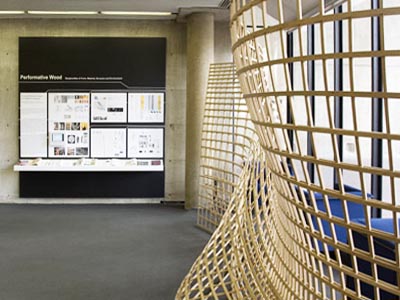Performative Wood:
Reciprocities of Form, Material, Structure, and Environment
The work presented in this exhibition investigates the largely unexplored field of computational design research that aims at integrating processes of form generation and materialization. Contrary to the still predominant modes of Computer Aided Design in use in today’s architectural practice, Computational Design externalizes the relation between form, formation, and information. For architecture as a material practice this enables an understanding of form, material, structure, and environment not as separate elements, but rather as complex, co-evolving systems that can be embedded in and explored through integral computational design processes. The projects exhibited here explore such an alternative, morphogenetic approach to architectural design, which unfolds specific material gestalt and related performative capacities from the synthesis of computational formation and physical materialization.
All exhibited work began with an in-depth research on the anatomy and behavior of wood, with the aim to investigate how one of the oldest construction materials can now be understood and employed as a natural, adaptable, high-performance fiber composite material. Wood differs from most building materials in that it is a naturally grown biological tissue. Thus wood displays significant differentiation in its material makeup and structure as compared to most industrially produced materials. Wood is anisotropic, it features different material characteristics and related behavior in different directions relative to the main fiber orientation. In addition, wood is also hygroscopic. It absorbs and releases moisture in exchange with the environment and these fluctuations cause dimensional changes. In architecture and structural engineering the anisotropic and hygroscopic characteristics of wood resulting from its internal cellular structure are often seen as problematic and disadvantageous compared to more homogeneous, isotropic and stable, industrially produced materials. The work presented here challenges this conception. It explores a computational design approach that aims at understanding wood’s complex material make up and behavior as a performative characteristic and distinctive design opportunity for architecture.

